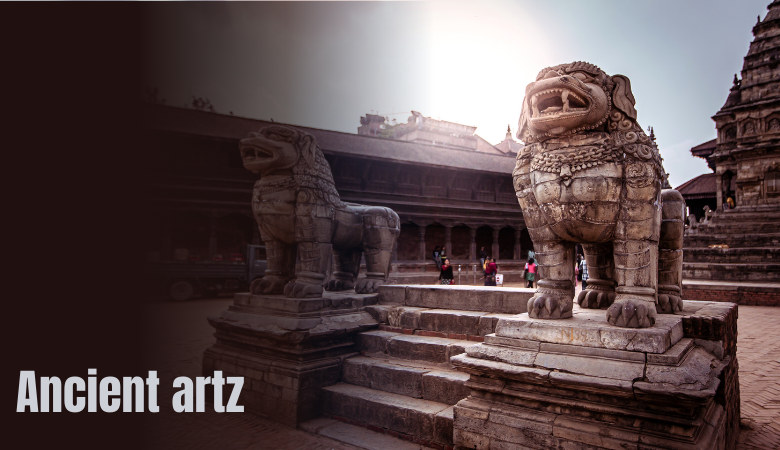Ancient Artz: Introduction

Ancient art provides a window into the past, showing us not only the aesthetics of bygone eras but also the values, beliefs, and everyday lives of the people who created it. Spanning across continents and thousands of years, ancient artz encompasses a variety of styles, mediums, and subjects, from the first cave paintings to grand temples and statues. It is not just about visual beauty; it’s about storytelling, ritual, and the preservation of culture. Without these works, much of history would be lost, leaving us with fragmented accounts of how ancient civilizations lived, thought, and expressed themselves.
The Earliest Forms of Art
Prehistoric Cave Paintings
Some of the earliest known art comes from prehistoric cave paintings. Found in places like Lascaux, France, and Altamira, Spain, these paintings date back to around 40,000 years ago. These early humans used natural pigments of ancient artz like to depict animals, hunting scenes, and perhaps spiritual practices. These works offer insight into the relationship early humans had with nature and their environment. Although rudimentary, they demonstrate a complex understanding of movement, form, and storytelling.
Sculptures of Prehistoric Times
In addition to cave paintings, prehistoric humans also created small sculptures, the most famous being the Venus figurines. These small, often exaggerated depictions of the female form are believed to represent fertility or mother goddesses. Found across Europe, they provide a glimpse into early religious or cultural practices.
Ancient Egyptian Art
Characteristics of Egyptian Art
Egyptian art is characterized by its distinct, formal style, with a heavy emphasis on symmetry and proportions. This art was largely centered around religion and the afterlife, as seen in the iconic pyramids, statues, and tomb paintings. The Egyptians believed that art helped guide the soul in the afterlife, which is why their works are often found in burial sites.
Iconography in Egyptian Tombs
The tombs of ancient Egyptian pharaohs were elaborately decorated with intricate murals and carvings. These works of art were not merely decorative; they served a religious purpose, illustrating the journey of the deceased through the afterlife.
The Role of Art in Egyptian Religion
Egyptian art was deeply intertwined with religious practice. Statues and paintings of gods and goddesses adorned temples, and many of their artistic works were created as offerings to deities. Artifacts like the Book of the Dead, with its rich illustrations, offer insights into the ancient Egyptian view of the world beyond.
Mesopotamian Art
Ziggurats and Architecture
Mesopotamian architecture, particularly the construction of ziggurats, represented their societal and religious priorities. These massive step-pyramids were dedicated to gods and were central to the cities that surrounded them.
Relief Sculptures in Mesopotamia
Mesopotamians are known for their detailed relief sculptures, often depicting scenes of war, mythology, and daily life. These carvings adorned temples and palaces, serving both decorative and narrative purposes.
Cylinder Seals and Their Use
One of the more unique art forms from Mesopotamia is the cylinder seal. These small, engraved cylinders were used to mark ownership and authenticate documents, demonstrating an intersection of art and bureaucracy.
Ancient Greek Art
Evolution of Greek Sculpture
Greek sculpture is celebrated for its evolution from stiff, formal figures to more naturalistic and dynamic representations of the human body. This progression can be seen from the early kouroi statues to the classical works of Phidias and Polykleitos, which exemplify balance and idealized beauty.
Pottery in Ancient Greece
Greek pottery is another essential part of their artistic legacy, featuring intricate designs that depict mythological scenes, historical events, and daily life. The red-figure and black-figure techniques are particularly well-known for their use of contrast and detail.
The Influence of Greek Art on the Roman Empire
Greek art heavily influenced Roman culture, especially in sculpture and architecture. The Romans adopted Greek techniques, but they added their flair, especially in portraiture and monumental architecture.
Roman Art and Architecture
Mosaics and Frescoes in Roman Culture
The Romans are famous for their mosaics and frescoes, which adorned the walls and floors of villas, public buildings, and bathhouses. These artworks often depicted mythological scenes, landscapes, and daily life in Roman society.
Roman Architecture: Arches, Domes, and Aqueducts
Roman architecture is also noteworthy, with innovations like the arch, dome, and aqueducts. These structures not only showcased Roman engineering prowess but also their appreciation for aesthetics and functionality.
Ancient Chinese Art
Terracotta Army of Emperor Qin Shi Huang
One of the most astonishing discoveries in ancient Chinese art is the Terracotta Army, a collection of over 8,000 life-sized statues buried with the first Emperor of China, Qin Shi Huang. Each figure is unique, showcasing the incredible craftsmanship of the time.
The Development of Chinese Calligraphy and Painting
Chinese art also saw the development of calligraphy and landscape painting, which became central to their artistic expression. Calligraphy, in particular, is considered one of the highest forms of art in Chinese culture, blending the beauty of characters with the art of writing.
Indian Art of Antiquity
The Influence of Hinduism and Buddhism
Indian art is deeply tied to religious themes, particularly those of Hinduism and Buddhism. Temples, sculptures, and paintings often depict deities and religious stories, with art being a form of devotion.
Rock-cut Temples and Sculptures
The rock-cut temples of India, such as those at Ajanta and Ellora, are marvels of ancient engineering and artistry. Carved directly into cliffs, these structures are adorned with intricate sculptures that depict religious themes and historical events.
Conclusion
Ancient art, spanning continents and millennia, offers a window into the past like no other. Through its varied forms, from Egyptian tomb paintings to Greek statues, it reflects the beliefs, aspirations, and everyday life of ancient civilizations. Today, the legacy of ancient art continues to inspire artists, historians, and anyone who seeks to understand humanity’s journey through time.



